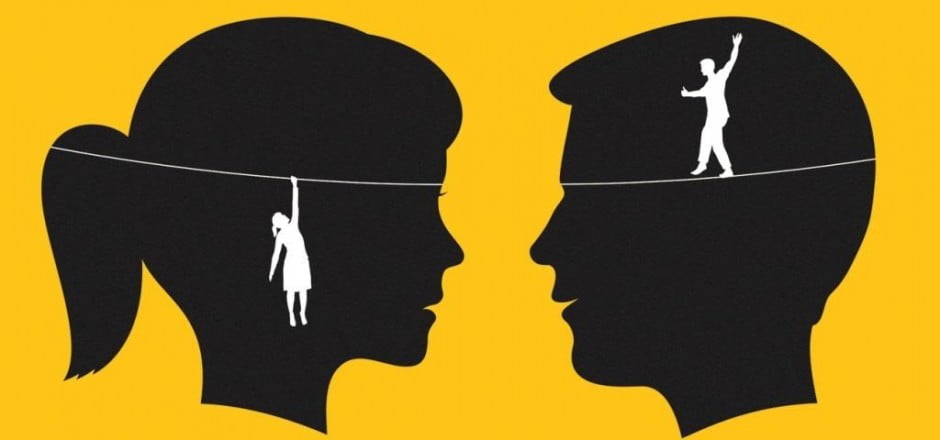The World Economic Forum (WEF) published its annual report on the global gender gap across a range of different dimensions. The purpose of this global gender gap report is for countries to assess whether they are making progress towards reducing the gender gap in health and survival, economic opportunities, education and political empowerment.
For nine continuous years, Iceland is on the top, for being the country that most equitably distributes resources between men and women. India ranks at 108 overall while in South Asia, India ranks 3rd, well behind Bangladesh, which despite being a poorer country, has a rank of 47 and also behind Maldives (106).
India’s Key Indicators
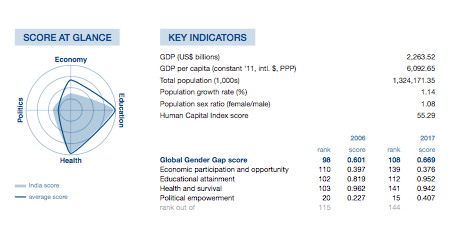
Figure 1 Source: Global Gender Gap Report
The figure above indicates that India’s score deviates from the average score for three out of four indices – Economy, Education and Health. The closer the score is to 1, higher the parity between men and women. The comparisons between 2006 and 2017 are very worrying.
Across all indicators except for Political Empowerment, our scores have fallen steeply. So India has been regressing in three out of the four measures. Further, India’s score relative to other countries, indicate that they have managed to close the gaps faster than India has.
Ranking on Specific Indicators
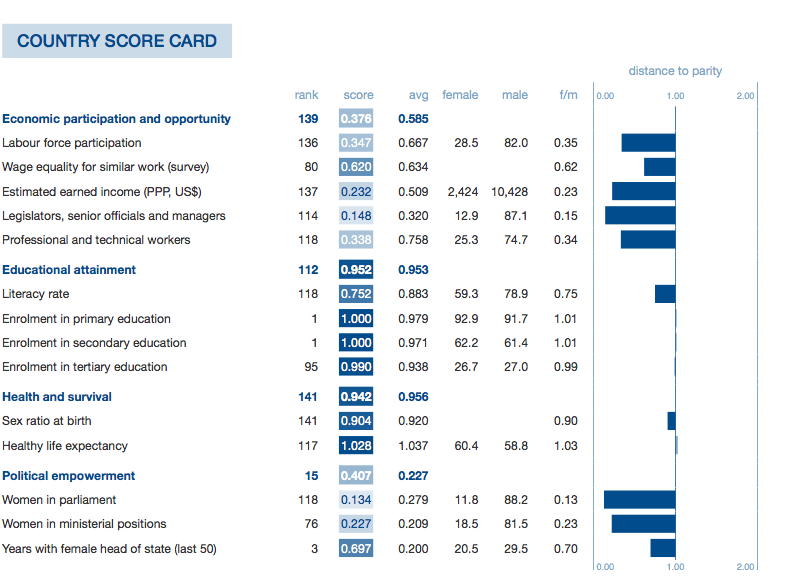
Figure 2 Source Gender Gap Report 2017
The figure above shows India’s scores on specific indicators within each dimension. Across all indicators, the country scores way below the average scores in the report. For some indicators like sex ratio at birth, life expectancy, labour force participation and estimated earned income, the results are particularly poor.
Health and Survival
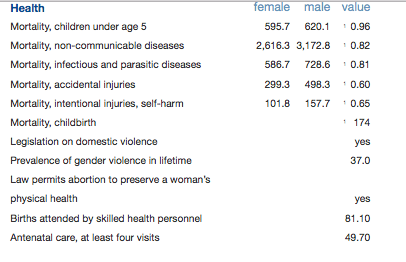
Figure 3 – Source Global Gender Gap Report 2017
India’s ranking on health and survival is the worst and we are in the bottom 3 at 141 because of our continued skewed sex ratio as well as poor indicators of maternal health including ante-natal care. There are 33 countries in the list which have reached parity for health and survival of which several of them are from Latin American countries.
For this particular index, only China and Azerbaijan do worse than us – the former because of decades of sex-selective abortions, which were worsened due to China’s one-child policy and the latter because of large gaps in life expectancy between men and women.
Economic Opportunity
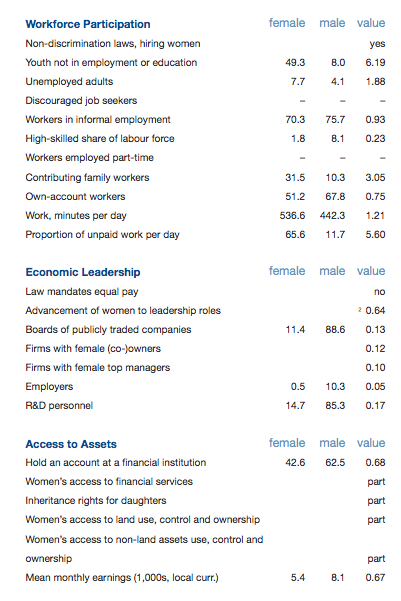
Figure 4 Source Global Gender Gap Report
For economic opportunity and participation, we rank at 139. There are just four countries – Iran, Pakistan, Yemen and Syria which fare worse. As the table above indicates, 6.5 times more young women are not in education or employment, when compared to young men, a staggering figure by all accounts!
Despite the existence of non-discriminatory laws, women constitute just 11% of the boards of publicly traded companies and form under 15% of the staff in Research and Development roles. Clearly, laws alone are inadequate in instituting reforms unless they are followed by concerted efforts on the parts of organizations to hire more women all across the board and especially in top leadership positions.
There are several issues related to the pipeline problem here – fewer working women imply that there will be fewer women available in the pipeline for top leadership positions. Subtle and not-so-subtle discriminatory practices also mean there is a ‘leaky’ pipeline issue. Women may enter professions at entry levels and then marriage and childbirth cause them to exit from the labour market. That may well explain the staggeringly large number of young women who are neither in education nor in employment.
This is also reinforced by the fact that 65.6% of the work done by women in India is unpaid work in contrast to just 11.7% for men. Also, less than 43% of women have an account in a financial institution, nearly 20% less than that of men. This figure for women is also likely to be much lower in the rural areas where financial inclusion for women in formal institutions is a serious problem.
Education
For educational attainment we fare slightly better at 112, having closed the gap in enrollment in primary and secondary education across most states in India. Further, as a country, India is slowly closing the gap in tertiary (higher) education.
While in many countries we see a gender difference in science graduation rates, this is not the case in India. 15% of both men and women graduate with degrees in the Natural Sciences, perhaps the only sliver of good news in this report. However, as expected, women are over-represented in the Social Sciences, Journalism and Education and underrepresented in Engineering, Manufacturing and Construction subjects.
Political Empowerment
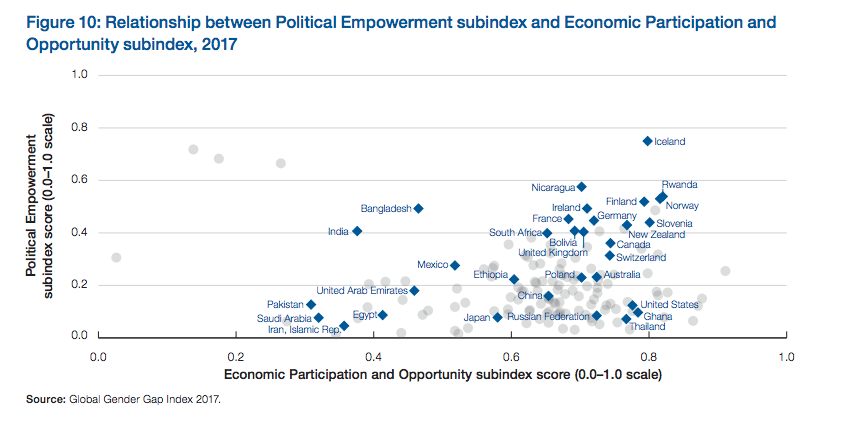
The figure above shows economic opportunity on the X-axis and the Political Empowerment Score on the Y-axis. The best rank we have among all the indicators is for political empowerment at 15 (down from 10 last year) because we are still resting on the laurels of having women as heads of state in the last decades.
Our ranking has gone down in 2017 because newly available data indicates that far fewer women are in middle-level managerial or technical or professional positions or are holding political office. There are extremely large income gaps and gaps in employment rates between equally educated men and women which are contributing to such poor outcomes for India.
Is our performance poor because India is a “developing country?”
Not entirely. One of the richest countries in the world – the United States is not even in the top 10% of all countries ranked and is at 49 on the Global Gender Gap Report 2017. Not all countries among the top 10 countries are from the industrialized West.
Rwanda ranks 4th, Nicaragua 6th, Slovenia 7th and Philippines 10th. The question for us is why and how have these countries managed to do so well despite having Gross Domestic Products which are far less than ours, economies which are perhaps not as vibrant as the Indian economy and diversity issues similar to those we have in India.
Critics will argue that it is the sheer size of India which makes it difficult for us to reduce disparities and also that these data are not good indicators because of the choice of the dimensions along which we are measured. Methodological quibbles aside, these are meant to be face-saving gestures.
India’s score deviates from the average score for three out of four indices – Economy, Education and Health.
The fact that we have fallen in the rankings in the last eight years, is a cause for genuine concern. For both health and survival and economic opportunities, concrete steps can be taken to improve outcomes. For the former, a lot more needs to be done to ensure that both sex-selective abortions and the neglect of the girl child are addressed.
It is harder to address the latter since it takes place in the context of families and entrenched patriarchal values, which overwhelmingly prefer sons and are difficult, though not impossible to change. For improving economic opportunities, the pipeline issues described earlier need to be addressed.
If women get married, have children and exit the labour force because of a gendered division of labour at home and the absence of affordable good quality childcare, then the benefits accrued from reducing educational gaps will be eventually nullified. All the countries which do well with regard to economic opportunities have excellent, publicly funded childcare including those in Latin America and Western Europe.
But given the state of basic public health in the country which is slowly getting privatised, it seems unlikely that under current administrative policies, the public sector’s role will expand to providing child care. What complicates the issue is that as long as the large wage gaps between men and women continue, affordable childcare will always remain a “woman’s problem”, rather than the problem for the family.
It is fundamentally immoral to have gender inequalities and it is unconscionable to have gender inequalities of the nature we have in India.
Also Read: A Crash Course on Workplace Gender Biases
Featured Image Credit: The Estonian
About the author(s)
Sreeparna Chattopadhyay has a Ph.D. in Cultural Anthropology from Brown University with research interests in gender and its intersections with health, education family and the law. She is an independent researcher.
